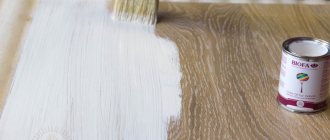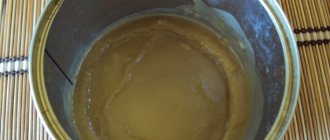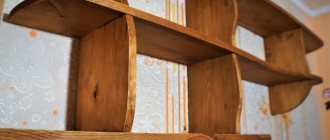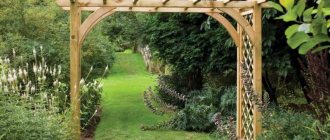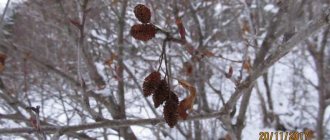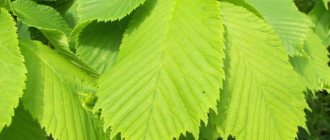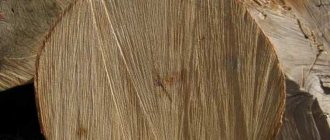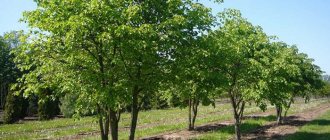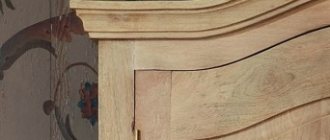With the onset of spring, the first aromas of plants appear in the garden. But color still plays a decisive role. This is why it is so important to use plants that have interestingly colored bark. They will allow the garden to look beautiful all year round. Trees with bark that has an original texture are of great value for landscapes in the middle zone. After all, this is where the color palette is not as bright as we would like.
Most often, brightly colored bark is found in smooth-stemmed plants. We are talking about two-year-old branches of bushes and young branches of the upper part of trees.
Trees and shrubs with red and brown bark
Such trees can often be found in gardens. They became very popular. They are used as a dominant composition in landscape design. The most striking representatives of trees with red bark are:
- White dogwood. In nature, this plant is found in the forests of the Caucasus and the Far East. This is a shrubby plant that grows up to one and a half meters in height, has opposite oval leaves, small yellow-green flowers, which are collected in heads. Flowering begins in mid-spring and continues for two to three weeks. After flowering, it forms edible yellow fruits, sweet and sour in taste, with an elongated seed inside. This is a perennial deciduous shrub. The leaves are about 5 cm long, glossy on top. Can be grown in sunny, shady or semi-shady areas. Not demanding on the type of soil, frost-resistant.
- Dogwood offspring. Its homeland is North America. In nature, it is found on the banks of reservoirs or in forests. It looks similar to the white dogwood, but its distinguishing feature is that it produces many lateral shoots. The shrub reaches 2.5 m in height, has coral-red glossy shoots and green leaves. It blooms in autumn with yellow flowers collected in thyroid inflorescences. At the end of summer it forms blue-white fruits.
- Dogwood is blood red. Often found in mixed forests and on the banks of water bodies. This perennial deciduous shrub grows up to 4 meters, has a wide crown with drooping shoots of different colors: green, purple or red. The leaves of the bush are oval, bright green, covered with fine fluff on top and thick fluff at the bottom. In autumn the leaves change color to bright red. Flowering begins in May. It blooms with small white flowers that form shield-shaped inflorescences 7 cm in circumference. Flowering lasts two to three weeks. The fruits are black and contrast beautifully with the bright green leaves.
- Bird cherry Maak. This is a perennial shrub plant that has an ambivalent attitude towards itself from gardeners. Some consider it attractive to harmful insects and a breeding ground for them; some value it for the beneficial properties of the berries. To find out for sure whether this plant is harmful or beneficial, it should be taken into account that the leaves and flowers contain phytoncides, which are released into the atmosphere and kill most pathogens and pests, such as mosquitoes or ticks. It is with this property of bird cherry that some people who place a bouquet of bird cherry flowers in their room then complain of a headache. The fruits of this plant are eaten. They contain many vitamins and microelements that have a beneficial effect on our body. Jam is made from the fruits of this plant, used as a filler for culinary dishes and eaten fresh. Maak bird cherry has red bark, thick emerald-colored leaves, and light yellow shoots. It blooms with snow-white flowers in spring, which then form clusters of black berries. The tree is especially decorative on bright sunny days, when its crown shines and the transverse stripes on the bark create the appearance of an openwork fringe. The tree grows up to 18 m in height, the thickness of the trunk is about 40 cm. Bird cherry flowers are honey-bearing, so during the flowering period there are a large number of bees in the crown of the tree.
- Pennsylvania bird cherry. This fruit tree grows up to 12 m in height, the bark has a red-cherry color, the trunk grows upright, the leaves are ovoid or elongated with a sharp end, green, about 10 cm long, changing color to red in autumn. It blooms with white flowers, which are collected in racemose inflorescences of 3-8 pieces. Fruiting begins at the age of three. The fruits are red, small in size, and eaten. Pennsylvania bird cherry is characterized by rapid growth, good frost resistance and drought tolerance. It can be grown in an urban climate, is not picky about the type of soil, and does not tolerate pruning. Used in single or group park plantings.
- Small-fruited strawberry. It is a smooth-bore tree with red bark. Belongs to evergreen deciduous trees of the Heather family. It has a decorative appearance throughout the year. During dry, hot weather, the skin of the bark cracks and peels off in thin strips, revealing the green bark underneath. This “molting” ends in August. The green bark changes color over time, darkens and becomes golden beige, then pinkish, orange and by January it acquires a coral color. The leaves on the branches also change. While the old leaves are falling off, new ones are growing at the same time. The leaves are elongated-oval in shape, at first not large in size so that the tree can spend the required amount of nutrients for renewal and growth. The process of photosynthesis occurs not only in the leaves, but also in the bark, which contributes to the rapid regeneration and renewal of the tree. Flowering begins in April or late winter. The tree is densely covered with small flowers that form racemose inflorescences. Flowers emit a pleasant aroma that attracts insects. The name “Strawberry” was not given to the tree in vain, since its fruits are very similar to strawberries. Strawberry fruits are small in size and have a neutral taste, while the large-fruited strawberry produces large, sweet berries.
- Cypress of Guadalupe. Refers to evergreen trees with copper-bronze colored bark. This tree is very frost-resistant and not fussy to grow. It has a spreading crown, reaches a height of up to 20 m. The bark tends to peel off and renew itself. It is rarely found commercially and is difficult to grow from seeds. Therefore, seeing it in parks and gardens is quite rare.
- Serrated cherry. Also known as Tibetan cherry. It is attractive with its red trunk with shiny bark, densely dotted with dashed stripes. The tree has a branched crown, grows up to 9 m in height, is a very unpretentious plant and can be grown on any type of soil. It is painful to tolerate stagnation of water and waterlogging. Cherry is frost-resistant and does not require special care or pruning. It has a decorative appearance at any time of the year. It blooms with white five-petaled flowers, from which soft fruits of a specific taste are formed.
Diseases and pests
Catalpa has good disease resistance. But to prevent the plant from being affected by the fungus, you should follow the watering schedule and regularly loosen the soil. Sometimes the tree is attacked by pests. Description of plant enemies:
- Shield. Its larvae attach to branches and fruits and suck the juices out of them. They can seriously damage and even kill young plants. The presence of scale insects is indicated by the sticky liquid (honeydew) that appears on the tree - this is their secretion. Insecticides have little effect on scale insects: insects are protected from them by a waxy coating on their shells. Larvae are removed from trees manually using a cotton swab moistened with the Aktara preparation. If there are not many pests, then the plants are sprayed with insecticides once or twice at an interval of two weeks.
- Spider mite. It can appear if there is hot, dry weather for a long time. This is a dangerous insect that sucks the juices from the plant. Its presence is indicated by cobwebs on leaves and branches. To kill mites, the tree is washed with a solution of sulfaride paste.
- Catalpa is often attacked by thrips - small insects that feed on sap and pollen. They fly from tree to tree and can carry dangerous diseases. To combat thrips, trees are sprayed with insecticides.
- The tree can also be attacked by Spanish fly. It heavily eats the leaves of the plant and contributes to the deformation of the shoots. To kill pests, plants are sprayed with insecticides.
Interesting! The hazelnut in your garden is Common Hazel.
Catalpa is a highly decorative tree. Its large leaves, fragrant flowers and long fruits always attract attention. In the southern regions, catalpa develops well and blooms profusely. In temperate climates, winter-hardy varieties are often grown as shrubs.
Trees and shrubs with green and yellow bark
Plants that constantly have yellow bark are called stem assimilates. These include:
- Whirlpool twig-shaped. Also known as Spanish gorse. It has a weeping appearance due to its thin and bending branches. The flowering period lasts for several months. If you do not want to get seed pods, you should remove the faded flowers immediately. The plant reaches up to 2 m in height and width. It is a deciduous shrub. Grown in open sunny places. It does not tolerate winter frosts and is a heat-loving plant. Loves sandy soils. Most often it is used as a hedge or group plantings. Tolerates winter pruning well.
- Greenbark maple. This tree belongs to the Maple family and can be found in the Primorsky Territory, China or Korea, as well as in nature reserves. In nature, it grows in mixed forests. It is a tree, about 15 m high, or a shrub with a spherical crown. It is distinguished by a very beautiful green color of the trunk with white stripes running along it. The color of the stripes indicates the age of the plant; in young ones it is white, in adults it is gray. Vervies are dark red in color. In the spring, large pink buds bloom on them. The leaves are about 17 cm long, wide, consist of three lobes, thin, silky to the touch, covered with veins. In autumn they change their color to golden yellow. The flowers are yellow-green, large in size, and borne in racemes. Flowering begins after the leaves bloom and lasts about two weeks. The plant is frost-resistant and fast-growing, can be grown in shaded areas, loves moisture and fertile soil. It has high seed germination and is a honey plant. Used in group or solo plantings in parks and alleys.
- Ephedra. Ephedra belongs to the Conifer family. Reaches a height of 1.5 m, has protruding upright branches with smooth green bark, covered with paired green leaves, dioecious flowers, which are collected in spike-shaped inflorescences. After flowering, it forms seed pods, which are an orange-red cone-berry. Grows in sunny or semi-shady areas. It is not picky about the type of soil, it is frost-resistant. It is used as a medicinal plant, as it contains a large amount of the alkaloid ephedrine, which is used to calm the nervous system in cardiovascular diseases, in the treatment of bronchial asthma, stop bleeding and as an antidote for poisoning with chemical and psychotropic substances.
- Bamboo-shaped leaf-grass or Castilon bamboo. This plant has a loose root system, is evergreen and grows quickly. Belongs to the Cereal family. It grows up to 20 m in height, has very strong thin stems, hollow inside. Complete formation of shoots occurs within several months. Produces long side shoots. The leaves are lanceolate, elongated, green. Bamboo is a perennial crop, but requires regular thinning. Propagated by seeds or vegetatively.
Tree care
If the location has been chosen correctly and the planting conditions have been met, then caring for the plants will be easy. Young trees are watered regularly. In the absence of natural precipitation, two buckets of water are poured weekly under each root. Weeds are regularly removed and the soil is loosened once a month.
In early spring and once or twice during the summer season, plants are fed with superphosphate, compost or rotted manure. Fertilizing is selected depending on the composition of the soil.
Mature plants overwinter quite well in temperate climates. Young trees are covered for the winter: the crown is covered with burlap, and the tree trunk is covered with leaves.
In the spring, when the threat of frost returning has passed, the shelter is removed. Despite good frost resistance, the tree’s young shoots often freeze. They need to be cut off immediately. Before the beginning of the growing season, you can also form a crown.
You should not prune the shoots too much - this causes thickening of the crown. The leaves will not have enough air and light, they will shred, and the plant will lose its decorative effect.
Trees and shrubs with white and black bark
Plants that have black bark never cease to amaze gardeners. These include:
- Black leaf-grass. This is bamboo with black trunks, which can be seen in Crimea. Its homeland of origin is China and Japan. It has a shorter stem height than the green psyllium. It is 5-7 cm. Due to its black shiny color, this bamboo is often used in the production of souvenirs and bamboo flutes. The plant is frost-resistant, however, it needs regular watering in the summer. Blooms once in a lifetime. To protect bamboo from death, it should be cut short. After some time it will recover and begin new growth. Young plants have black-brown stems that become completely black after the second year. Propagated vegetatively, grown on fertile loose soil in semi-shaded places.
- Plants that have snow-white bark include Jacqueline birch. It ranks first in terms of snow-white trunk. However, only six years after planting does its bark acquire a pure white appearance. The birthplace of this birch is the Himalayas, so it can withstand even the most severe frosts. This tree loves light and can be grown in semi-shaded places. Loves moist, well-drained soil. Refers to slow growing trees. The average height is 12 m, trunk girth is 5-7 m. Often used in group plantings, mixborders and alleys.
What color can the bark be?
Most deciduous and coniferous trees have interesting bark. In Scots pine it is bright orange, in birch it is white. Willows and Maak bird cherry look beautiful and unusual.
The original color is of the eastern plane tree, which has a camouflage trunk, but it is not widespread in Russia.
At the same time, regardless of the shade, you should follow one simple rule - plant plants in the foreground, at the edge, near paths. The thing is that colors are better perceived at close range.
Trees and shrubs with spotted bark
Mottled bark on tree trunks results from the peeling of the top layer of bark, which has a different color than the bottom layer. During the process of exfoliation, the plant is renewed and rejuvenated. Such plants include plane trees, legestremia lygian, Indian lilac, southern bunge pine and others.
- Sycamore. Also known as eastern maple. Refers to very long-lived plants. There are specimens in nature that are more than 2000 years old. One of these representatives can be seen in Turkey. Scientists have determined its age to be 2300 years. It reaches a height of 60 m, the girth of the trunk is 42 m. The leaves of the plane tree are very similar to maple, but a little larger. The plant has earned love due to its ability to produce dense shade and provide shelter from the cool in sultry heat. Especially popular in South-Eastern countries with hot climates. The tree is deciduous, will grow up to 30 m in height, the branches can bend, and tend to the ground. The five-lobed green leaves reach a length of 15 cm and the same width. The fruits of the plane tree are nuts that ripen during the winter, fall apart in the spring and are carried by the wind.
- Lagerstroemia or Indian lilac. Lagerstroemia is a deciduous shrub that belongs to the Derbennikov family. China is considered its homeland, but you can see it in all corners of the planet. It is distinguished by decorative flowers with a delicate scent and layered bark. The dark green leaves change color to red or yellow closer to autumn. Flowering begins in mid-summer and continues until the first frost. The flowers are collected in racemes up to 40 cm long. The color can be pink, red, purple, white, cream or beige. It is grown in the southeastern or southwestern areas, both at home and in open ground. Used to decorate flower beds, flower beds, and park areas. A distinctive feature of Indian lilac is that it begins to awaken from winter later than other plants and creates the impression of its death. It is considered a medicinal plant that is used to normalize blood sugar levels and for weight loss, as it contains gallic acid, which breaks down fats.
- Bunge pine. This tree grows up to 20 m in height, has crooked branches and an upright trunk. The bark peels off to form a colorful camouflage pattern. The color of the bark changes as the tree ages. Old trees have red, purple or gray tones. Young ones are gray-green or silvery in color. The leaves are elongated oval in shape and transmit light well. The needles are hard, dark green in color, and fit tightly together, up to 9 cm in length. It is a slow growing plant that grows well in light, loose soils with low acidity.
Read: “Lacy” trees and shrubs
Join our Facebook group
Planting in open ground
Well-lit places are selected for catalpa. The tree also grows well in partial shade. The planting site should be protected from drafts - strong winds damage the delicate leaves of the plant.
The soil must be drained and have good air permeability. Catalpa does not tolerate marshy soils. Groundwater must also lie deep enough. The plant grows well on loamy soils with the addition of organic fertilizers. If the soil is heavy, then dig it up and add compost mixed with gravel. Trees are planted individually or form a whole alley. Planting is done as follows:
- The soil is prepared from a mixture of 3 parts humus, 2 parts leaf soil, one part peat and one part sand. The acidity of the mixture should be neutral.
- Prepare holes for planting with a depth of at least 70 centimeters, located at a distance of at least 4-5 m from each other. A drainage layer of broken bricks or shards is added to the bottom of each.
- 5-8 kg of ash, 50 g of phosphorus flour are poured into the pits and two buckets of water are poured.
- The seedlings are installed vertically and covered with soil so that the root collar is at ground level, and the earthen ball is 20-30 cm higher. The earth will gradually become denser and sink.
- The tree trunk circle is mulched with peat in a layer at least 5 cm thick.
Cool and beautiful plant! Thuja Western Smaragd - read.
